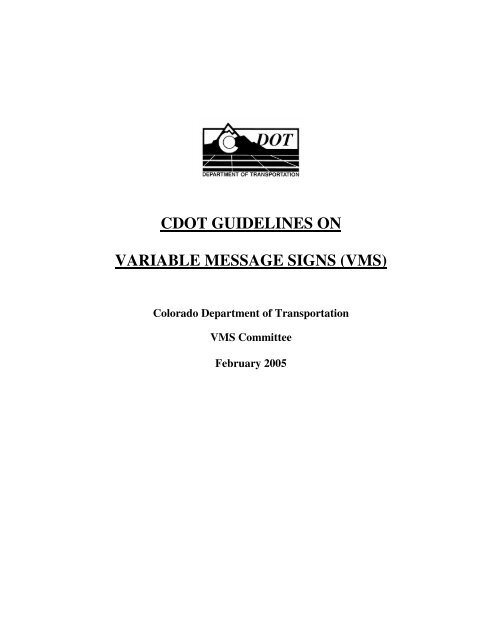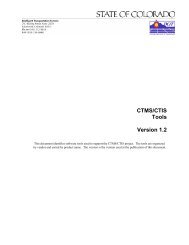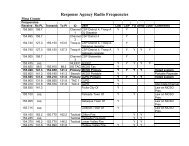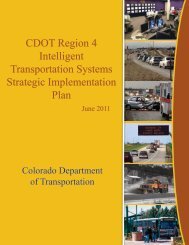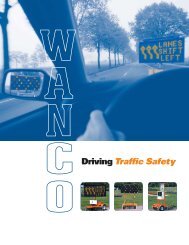CDOT Guidelines on Variable Message Signs (VMS) - Colorado ...
CDOT Guidelines on Variable Message Signs (VMS) - Colorado ...
CDOT Guidelines on Variable Message Signs (VMS) - Colorado ...
You also want an ePaper? Increase the reach of your titles
YUMPU automatically turns print PDFs into web optimized ePapers that Google loves.
<str<strong>on</strong>g>CDOT</str<strong>on</strong>g> GUIDELINES ONVARIABLE MESSAGE SIGNS (<strong>VMS</strong>)<strong>Colorado</strong> Department of Transportati<strong>on</strong><strong>VMS</strong> CommitteeFebruary 2005
C<strong>on</strong>tentsOverview Page 3Introducti<strong>on</strong> Page 3Principles Page 3When to Use a <strong>VMS</strong> Page 4Incidents Page 4Traveler Informati<strong>on</strong> Page 5Public Service Announcements Page 6Blank <strong>Signs</strong> Page 7<strong>Message</strong> C<strong>on</strong>tent Page 7Timing Page 7Limit Panels Page 8<strong>Message</strong> Unit Page 8<strong>Message</strong> Length Page 8<strong>Message</strong> Familiarity Page 9<strong>Message</strong> Sets Page 9Advisory <strong>Signs</strong> Page 9Guide <strong>Signs</strong> Page 10Advance <strong>Signs</strong> Page 10The Portable <strong>VMS</strong> Page 10References Page 11Appendix A – Typical <str<strong>on</strong>g>CDOT</str<strong>on</strong>g> <strong>VMS</strong> <strong>Message</strong>s Page 12-18Appendix B – Comm<strong>on</strong> Abbreviati<strong>on</strong>s Page 192
OVERVIEWThe purpose of these guidelines is to ensure that <strong>Variable</strong> <strong>Message</strong> Sign (<strong>VMS</strong>) messages are usedto inform and direct motorists of variable situati<strong>on</strong>s in a c<strong>on</strong>sistent and orderly manner. Themessages are for the purpose of traffic c<strong>on</strong>trol, management and timely traveler informati<strong>on</strong>.INTRODUCTION<strong>Variable</strong> <strong>Message</strong> <strong>Signs</strong> (<strong>VMS</strong>), also known as Dynamic <strong>Message</strong> <strong>Signs</strong> (DMS), <strong>Variable</strong><strong>Message</strong> Boards (VMB), or Changeable <strong>Message</strong> <strong>Signs</strong> (CMS), are a valuable and effective trafficc<strong>on</strong>trol tool available for c<strong>on</strong>structi<strong>on</strong>, incident management, traveler informati<strong>on</strong> and maintenanceactivities today. In additi<strong>on</strong>, they can be effective for large special events that significantly affecttraffic flow. Care must be taken, however, that the <strong>VMS</strong> not be used for advertising. Usedeffectively, the <strong>VMS</strong> will provide changing – but specific informati<strong>on</strong> to the driver. For example:A roadway problemThe approximate locati<strong>on</strong>The instructi<strong>on</strong> to the motoristLEFT LANE CLOSED1 MILEMERGE RIGHTThere are several possible roadway elements that a <strong>VMS</strong> can be utilized to notify the travelingpublic about. These include:C<strong>on</strong>structi<strong>on</strong>Incident ManagementTraveler Informati<strong>on</strong>Maintenance ActivitiesAs with other traffic c<strong>on</strong>trol devices, credibility of the message is critical. Without credibility,even the best message will go unheeded. Care must be taken not to display a message thatmotorists will disregard or will discover to be incorrect. <strong>Signs</strong> are the primary channels ofcommunicati<strong>on</strong> to the motorist.PRINCIPLESThis guideline sets forth the basic principles governing the use of <strong>VMS</strong> messages. As stated in theMUTCD, Secti<strong>on</strong> 1A.02, to be effective, the <strong>VMS</strong> message should meet the followingrequirements:• Fulfill a need• Command attenti<strong>on</strong>• C<strong>on</strong>vey a clear, simple meaning• Command respect of road users• Give adequate time for proper resp<strong>on</strong>se3
Each <strong>VMS</strong> message shall be displayed for a specific purpose such as those provided in thisguideline. <strong>VMS</strong> messages requested for roadway c<strong>on</strong>diti<strong>on</strong>s or restricti<strong>on</strong>s should be removedimmediately when those c<strong>on</strong>diti<strong>on</strong>s cease to exist or the restricti<strong>on</strong>s are withdrawn. Identicalc<strong>on</strong>diti<strong>on</strong>s should always be given the same <strong>VMS</strong> message irrespective of where the c<strong>on</strong>diti<strong>on</strong>soccur.WHEN TO USE A <strong>VMS</strong>As stated in “<str<strong>on</strong>g>CDOT</str<strong>on</strong>g> <strong>VMS</strong> Usage Policy”, it is <str<strong>on</strong>g>CDOT</str<strong>on</strong>g> policy that the <strong>Colorado</strong> TrafficManagement Center (CTMC) shall have the authority to place messages <strong>on</strong> a <strong>VMS</strong> that the CTMCcan c<strong>on</strong>trol, statewide, when the message c<strong>on</strong>tent is requested from a verifiable and credible source(e.g., <str<strong>on</strong>g>CDOT</str<strong>on</strong>g>, <strong>Colorado</strong> State Patrol). The CTMC will be resp<strong>on</strong>sible for removal of said messagewhen applicable. The individual <str<strong>on</strong>g>CDOT</str<strong>on</strong>g> Regi<strong>on</strong>s, however, will have override authority for the<strong>VMS</strong> boards in their Regi<strong>on</strong>. <strong>Message</strong>s dealing with traveler safety and road c<strong>on</strong>diti<strong>on</strong>s shall takeprecedence over informati<strong>on</strong>al messages.As stated in the MUTCD, Secti<strong>on</strong> 2E.21: “Changeable message signs shall display pertinent trafficoperati<strong>on</strong>al and guidance informati<strong>on</strong> <strong>on</strong>ly, not advertising.”With these facts in mind, the following are examples of when to use a <strong>VMS</strong>.Incidents1.) AccidentsAn incident with a minimum of blockage and with short time durati<strong>on</strong> is not appropriatefor a <strong>VMS</strong> warning. The situati<strong>on</strong> will probably be cleared before the message is placed <strong>on</strong>the <strong>VMS</strong>.Incidents that block lanes for substantial periods of time are ideal for getting informati<strong>on</strong> tothe traveling public. <strong>Message</strong>s near the incident can inform motorists of the problem andmove cars into open lanes. <strong>Signs</strong> farther away from the incident can suggest alternateroutes.2.) Traffic Diversi<strong>on</strong>Traffic is comm<strong>on</strong>ly diverted, such as when a road or pass is closed due to weather.3.) Incident Management Plan (IMP)Use <strong>VMS</strong> signs per the traffic management strategies outlined in the IMP. Regi<strong>on</strong>al,corridor-wide as well as project-wide incident management plans have been developed tofacilitate resp<strong>on</strong>se to incidents and help mitigate traffic c<strong>on</strong>gesti<strong>on</strong>. As directed by theIncident Commander, implementati<strong>on</strong> of various levels of traffic management plans forincident management (i.e. use of pre-identified traffic detour routes) incorporate strategicuse of <strong>VMS</strong> signs.4
4.) Notice of RoadworkThis warns motorists of upcoming c<strong>on</strong>structi<strong>on</strong> activities that will impact traffic flow. Thismay include lane closures, lane shifts, two-way traffic, shoulder work, and c<strong>on</strong>structi<strong>on</strong>traffic entering the highway, detours, etc. This will supplement normal roadwork signingas required by the MUTCD.5.) Regulatory<strong>VMS</strong> are currently allowed by law to be used for regulatory purposes in two situati<strong>on</strong>s:during the use of High Occupancy Vehicle (HOV) lanes, and to inform drivers the chainlaw is in effect. <strong>VMS</strong> can be used to supplement regulatory signs.6.) Adverse Weather and Roadway C<strong>on</strong>diti<strong>on</strong>s<strong>Message</strong>s will be used to display adverse weather or roadway c<strong>on</strong>diti<strong>on</strong>s downstream thatmay impact the drivers’ visibility or safety. These c<strong>on</strong>diti<strong>on</strong>s may include snow, icyroadways, fog, dust storms, falling rocks, mudslides, high winds, etc.7.) Operati<strong>on</strong> With Lane C<strong>on</strong>trol SignalsTypically used in the tunnels, these signs have a red ‘X’ in the closed lane and a greenarrow in the open lane.Traveler Informati<strong>on</strong>1.) Display of Future RoadworkMotorists will be warned of road c<strong>on</strong>structi<strong>on</strong> activities in the near future (within a week)that will adversely affect traffic. These messages will give the regular traveler a chance tochange routes or travel times.2.) Display Informati<strong>on</strong> for Other StatesAdjacent states may have incidents that force the closure of a major highway. <strong>Message</strong>s <strong>on</strong>the same corridor or c<strong>on</strong>necting corridor can inform interstate travelers of the incident.3.) Test <strong>Message</strong>sDuring initial <strong>VMS</strong> burn-in or during maintenance, test messages are a necessary functi<strong>on</strong>.These messages are for limited durati<strong>on</strong>.4.) Future TechnologyThere is experimentati<strong>on</strong> using ITS traffic m<strong>on</strong>itoring devices to determine travel times todestinati<strong>on</strong>s. Once this technology is tested for reliability, travel times could be posted <strong>on</strong>the <strong>VMS</strong> <strong>on</strong> high-c<strong>on</strong>gested corridors.5
5.) Special Events that Affect Traffic FlowThese messages display informati<strong>on</strong> about future events that affect traffic flow and safety.The Regi<strong>on</strong> Traffic Engineer will approve the use of the signs. In urban areas thesemessages shall be used <strong>on</strong>ly <strong>on</strong> high-speed facilities, unless otherwise approved by theRegi<strong>on</strong> Traffic Engineer. There may be times where static signs would be a moreappropriate use. The messages should be displayed within a week of the event.Public Service AnnouncementsIn general, public service announcements (PSA) may be displayed <strong>on</strong> a limited and shorttermbasis. The <strong>VMS</strong> should be used sparingly for the PSA so that the primary purposeand l<strong>on</strong>g-term effectiveness of these signs will not be degraded. The PSA shall not bedisplayed in urban areas during the peak travel periods. Special event signing, notificati<strong>on</strong>of future roadway c<strong>on</strong>structi<strong>on</strong>, and displaying messages for other states are all forms ofpublic service announcements and have been adequately addressed in previous secti<strong>on</strong>s.However, there are additi<strong>on</strong>al categories of PSA messages appropriate for <strong>VMS</strong> use, asdescribed below. Most PSA messages will fall into <strong>on</strong>e of these categories, though theremay be others such as n<strong>on</strong>-typical truck load restricti<strong>on</strong>s, homeland security informati<strong>on</strong>pertinent to travel, natural disaster notificati<strong>on</strong>, and evacuati<strong>on</strong> route informati<strong>on</strong> thatwould be appropriate as a PSA. Under no circumstances shall the <strong>VMS</strong> be used foradvertising of any kind. The PSA shall not be displayed prior to the approval of theRegi<strong>on</strong>’s Traffic Engineer, except as described below.1.) Amber Alert<str<strong>on</strong>g>CDOT</str<strong>on</strong>g> in partnership with the <strong>Colorado</strong> Bureau of Investigati<strong>on</strong> established an AmberAlert Policy in the event of child abducti<strong>on</strong>. <strong>VMS</strong> procedure is detailed in that policy.These messages do not require the specific approval of the Regi<strong>on</strong> Traffic Engineer, butwill be placed <strong>on</strong> <strong>VMS</strong> by the CTMC in accordance with the prescribed policy procedure.2.) Fire DangerDue to the nature of travel across <strong>Colorado</strong>, messages such as c<strong>on</strong>trolled burn, forest fireand fire ban informati<strong>on</strong> are c<strong>on</strong>sidered appropriate messages. The U.S. Forest Servicewill notify the CTMC in the event of a high or extreme fire danger. Those messages willbe placed <strong>on</strong> the <strong>VMS</strong> near the state border and <strong>on</strong> the highway corridor leading into themountains.3.) Driver Safety Campaigns<strong>Message</strong>s related to driver safety campaigns will be allowed if other media is used, such asradio, TV, newspapers, billboards, etc. This is necessary since the message could bec<strong>on</strong>fusing to drivers if they have not been exposed to the informati<strong>on</strong>. In this case the<strong>VMS</strong> should be used randomly, and sparingly. The total durati<strong>on</strong> of display in these casesshould not exceed two hours per day <strong>on</strong> any <strong>on</strong>e message board. The display times will bestaggered, so the message will not appear at the same time each day, and care must betaken so the staggered times do not fall c<strong>on</strong>secutively.6
Blank <strong>Signs</strong>A <strong>VMS</strong> will be in a blank mode during the peak and off-peak periods when traffic, roadway,envir<strong>on</strong>mental, or pavement c<strong>on</strong>diti<strong>on</strong>s, or public service announcements do not warrant thedisplay of a message, or messages.MESSAGE CONTENT<strong>Variable</strong> <strong>Message</strong> <strong>Signs</strong> do provide a versatile means of communicati<strong>on</strong>. The message, however,must be c<strong>on</strong>cise and clear for the drivers to interpret at high speeds while they can have anynumber of distracti<strong>on</strong>s. This secti<strong>on</strong> will illustrate how to write and display the message to givebrief, clear and accurate informati<strong>on</strong> to the motorists.TimingThe reading time is the time it actually takes a driver to read a sign message. The exposure time isthe length of time a driver is within the legible distance of the message. So the exposure time mustalways be equal to or greater than the reading time. Depending up<strong>on</strong> the speed of the drivers, themessage length must be adjusted to insure the reading time can fit into the exposure time.The Traffic C<strong>on</strong>trol Devices Handbook by the Institute of Transportati<strong>on</strong> Engineers states theMUTCD requires minimum legibility of portable variable message signs at 650 feet and 1,000 feetfor higher speed facilities. The following shows how many sec<strong>on</strong>ds it takes to travel 1,000 feet atvarious speeds.SpeedTime to Travel 1,000 feet (sec<strong>on</strong>ds)45 15.255 12.365 10.575 9.1When the <strong>VMS</strong> displays a series of message panels, 2-4 sec<strong>on</strong>ds per message panel isrecommended. The blinking feature may be used <strong>on</strong> <strong>on</strong>e or more of the panels. It should howevernot be used for more than <strong>on</strong>e line of each panel.The following table shows the maximum number of message panels that can be displayed for eachspeed limit, and provided there is at least 1,000 feet of site distance.Speed Limit (MPH)Number of <strong>Message</strong> Panels45 3 (see “Limit Panels” secti<strong>on</strong>)55 3 (see “Limit Panels” secti<strong>on</strong>)65 2 (see “Limit Panels” secti<strong>on</strong>)75 2 (see “Limit Panels” secti<strong>on</strong>)7
If <strong>on</strong>ly <strong>on</strong>e message panel is used, the sign may be at steady burn and the blinking feature may alsobe used for a single message (<strong>on</strong>e message panel). For example, the single message panel mayalso be <strong>on</strong> for 2 sec<strong>on</strong>ds and off for 1 sec<strong>on</strong>d.Limit PanelsThe limitati<strong>on</strong>s to the number of message panels to use is twofold:1. Motorists should be able to read the message twice while traveling at the posted speed.2. When more than two screens (panels) are used, the message and its order becomec<strong>on</strong>fusing to the motorist. The message shall be kept to two panels, except as describedbelow:a. The chain law, as three panels must be used to get all the pertinent informati<strong>on</strong> tothe drivers.b. As approved by the Regi<strong>on</strong> Traffic Engineer for safety or emergency reas<strong>on</strong>s.Again, the average motorist at a high rate of speed can comprehend two message panels. If threepanels are necessary, keep the c<strong>on</strong>fusi<strong>on</strong> minimized. Each panel should be a complete phrase andeach phrase should be independent of the other. If the motorist begins reading the message at the2 nd or 3 rd panel, the total message should make sense.<strong>Message</strong> UnitIn each message there are units of informati<strong>on</strong>. A unit is <strong>on</strong>e separate piece of data that the drivercan recall and use to make a decisi<strong>on</strong>. A unit normally is <strong>on</strong>e or two words but can be up to fourwords l<strong>on</strong>g. For example, the following message has four units of informati<strong>on</strong>:What happened?Where?Who is affected?What must they do?I-25 CLOSEDAT EXIT 287 WELLINGTONALL TRAFFICMUST EXIT<strong>Message</strong> LengthThe message-load for the above is 4 units. That is reaching the limit for an average pers<strong>on</strong> tounderstand while traveling at a high speed. The message length is the number of words orcharacters in the message. The average motorist traveling at a high rate of speed can handle 8word messages of 4 to 8 characters per word, (excluding prepositi<strong>on</strong>s). The number of panels orframes is another important variable in the c<strong>on</strong>structi<strong>on</strong> of a clear message.<strong>Message</strong> Familiarity<strong>Message</strong> familiarity is another aide for motorist ability to understand a message. Wheninformati<strong>on</strong> displayed to motorists is unusual, l<strong>on</strong>ger comprehensi<strong>on</strong> time is required. Comm<strong>on</strong>language is necessary. Appendix A c<strong>on</strong>tains a list of typical messages in many of the <strong>VMS</strong>8
memories. Appendix B c<strong>on</strong>tains a list of comm<strong>on</strong> abbreviati<strong>on</strong>s. Both attachments are valuableresources because this will help standardize messages and help motorists comprehend quickly.To further message comprehensi<strong>on</strong>, the following are suggesti<strong>on</strong>s taken from research c<strong>on</strong>ductedby the Texas Transportati<strong>on</strong> Institute c<strong>on</strong>cerning messages drivers can comprehend the quickest:• Drivers have difficulty corresp<strong>on</strong>ding calendar days to days of the week. For example,“TUES – FRI” is preferred over “OCT 1 - OCT 4”.• Drivers find the phrase “FOR 1 WEEK” ambiguous. It is preferable to use “WED–TUES”.• Most drivers felt the term “WEEKEND” meant the work would begin Saturday morningand be complete by Sunday evening. It is recommended times and days be used if thework begins <strong>on</strong> Friday and extends to M<strong>on</strong>day.• The highway or route numbers should be displayed with the route or interstate designati<strong>on</strong>.The number al<strong>on</strong>e can be c<strong>on</strong>fusing to both local and drivers from other areas.• A unit of informati<strong>on</strong> may be displayed <strong>on</strong> more than <strong>on</strong>e line <strong>on</strong> the <strong>VMS</strong>. A sign lineshould not c<strong>on</strong>tain more than two units of informati<strong>on</strong>.<strong>Message</strong> SetsExperience has shown there are three types of elements to use when messages fall under thecategories of Incidents and Traveler Informati<strong>on</strong>, as follows:Advisory <strong>Signs</strong>The advisory signs display real-time informati<strong>on</strong> about freeway status and advisories c<strong>on</strong>cerningthe best course of acti<strong>on</strong>. These will mostly be used for incidents. The advisory sign messageshould c<strong>on</strong>sist of the following:• A problem statement (accident, road closure, c<strong>on</strong>structi<strong>on</strong>, adverse weather, etc.)• An effect statement (delay, c<strong>on</strong>gesti<strong>on</strong>, etc.)• An attenti<strong>on</strong> statement (addressing a certain group or audience)• An acti<strong>on</strong> statement (what to do)The minimum informati<strong>on</strong> is the problem and acti<strong>on</strong> statements. The locati<strong>on</strong> of the problem isalso sometimes useful in a diversi<strong>on</strong> decisi<strong>on</strong>.HIGH WIND< Problem StatementRESTRICTION< Effect StatementHIGH PROFILE VEHILES < Attenti<strong>on</strong> StatementMAY BE STOPPED < Acti<strong>on</strong> StatementGuide <strong>Signs</strong>Guide signs are necessary if the traffic must be diverted due to an incident or c<strong>on</strong>structi<strong>on</strong>. Theguide signs must provide destinati<strong>on</strong> informati<strong>on</strong> and route affirmati<strong>on</strong> and directi<strong>on</strong>.9
Advance <strong>Signs</strong>There are times to inform drivers of incidents that are farther ahead of the current locati<strong>on</strong>. Thisup-to-date informati<strong>on</strong> has the following basic elements that can be communicated:• Informati<strong>on</strong> alert• Nature of informati<strong>on</strong> (best route, traffic c<strong>on</strong>diti<strong>on</strong>s, etc.)• Destinati<strong>on</strong> for which informati<strong>on</strong> applies• Locati<strong>on</strong> of the informati<strong>on</strong> (AHEAD or specific distance)If there is a diversi<strong>on</strong> situati<strong>on</strong> with known alternative routes available:• Route markers of the major alternative routes.THE PORTABLE <strong>VMS</strong>The above guidelines apply to all types of <strong>VMS</strong>, but because of its nature, the following additi<strong>on</strong>alguidelines are applicable to the portable <strong>VMS</strong>.The proper placement of a portable <strong>VMS</strong> is critical to its effectiveness. The placementrequirement must give the motorist adequate time to react to the message. The <strong>VMS</strong> must belocated prior to major decisi<strong>on</strong> points, such as intersecti<strong>on</strong>s or interchanges, where the driver maychange their travel plans. (On the Interstate, or other access-c<strong>on</strong>trolled freeways, placement 1 mileprior to the interchange is recommended.) Also, it must be placed prior to the present andexpected traffic backups.Placement requirements include:• To provide 800 feet of sight distance.• Where signs, poles, or other objects will not obstruct the <strong>VMS</strong>.• On a level surface.• Not within an intersecti<strong>on</strong> or interchange.• Should not interfere with other traffic c<strong>on</strong>trol devices.If more than 2 <strong>VMS</strong> are to be used in sequence, they should be separated by at least 1,000 feet.The sign should be placed off of the shoulder of the roadway, behind the guardrail, if possible, andwhere it will be accessible to maintenance vehicles even if the traffic queue develops or grows.To be comfortable to read, the <strong>VMS</strong> panel should be turned slightly towards the driver’s view, atapproximately 5 to 10 degrees from perpendicular of the road’s centerline. Reading the <strong>VMS</strong>becomes more difficult as the angle is increased from the normal field of visi<strong>on</strong>. It isrecommended to drive by the <strong>VMS</strong> after installati<strong>on</strong> to be sure the sign is readable from the road.If the portable <strong>VMS</strong> is set up al<strong>on</strong>g the roadway and a message will not yet be needed for a periodof 4 hours or more, the sign panel should be turned away from traffic, parallel to the road’scenterline. No blank signs should be facing the drivers for extended periods.10
References:-Manual <strong>on</strong> Uniform Traffic C<strong>on</strong>trol Devices (MUTCD), Millennium Editi<strong>on</strong>, Revisi<strong>on</strong> 1,12/28/01-Traffic C<strong>on</strong>trol Devices Handbook, 2001, Institute of Transportati<strong>on</strong> Engineers-Dudek, C.L., N. Trout, S. Booth, and G. Ullman, Improved Dynamic <strong>Message</strong> Sign <strong>Message</strong>s andOperati<strong>on</strong>s, FHWA/TX-01/1882-2, Texas Transportati<strong>on</strong> Institute, The Texas A&M UniversitySystem, College Stati<strong>on</strong>, Texas, 77843-3135, October 2000.11
Appendix ATypical <str<strong>on</strong>g>CDOT</str<strong>on</strong>g> <strong>VMS</strong> <strong>Message</strong>sCHAINSCHAINSCHAINSCHAINSCHAINS1-DRIVE AXLE COMBO COM VEHICLES ONLY CHAINS REQUIREDALL VEHICLES CHAINS REQUIREDALL VEHICLES MUST USE CHAINS OR SNOWTIRESCHAIN UP STATION MM ___COM VEHICLES ONLY CHAINS REQUIREDCLOSUREACCIDENT AHEAD ROAD CLOSEDCLOSURECENTER LANE CLOSED AHEADCLOSUREEXIT CLOSED AHEADCLOSUREFRONTAGE ROAD CLOSEDCLOSUREI-25 AND US 287 CLOSED TO WYOMINGCLOSUREI-25 CLOSED AT EXIT 287 WELLINGTON ALL TRAFFIC MUST EXITCLOSUREI-25 OVERNIGHT CLOSURE: ____ TO ____ 11PM-5:30AMCLOSUREI-80 CLOSED AT OGALLALA, NECLOSUREI-80 CLOSED CHEYENNE TO LARAMIECLOSURELEFT LANE CLOSEDCLOSURELEFT LANE CLOSED AHEADCLOSURELEFT SHOULDER CLOSED AHEADCLOSURERAMP CLOSEDCLOSURERAMP CLOSED AHEADCLOSUREREST AREA CLOSEDCLOSURERIGHT LANE CLOSEDCLOSURERIGHT LANE CLOSED AHEADCLOSURERIGHT SHOULDER CLOSED AHEADCLOSUREROAD CLOSEDCLOSUREROAD CLOSED ____ MILES AHEAD12
CLOSUREROAD CLOSED AHEADCLOSUREROAD TEMPORARILY CLOSEDCLOSURETUNNEL CLOSED AHEADCLOSUREUS 287 CLOSED MM 355 INTO WYOMINGCONSTRUCTIONBRIDGE WORK AHEADCONSTRUCTIONCONSTRUCTION AHEAD EXPECT DELAYSCONSTRUCTIONCONSTRUCTION NEXT ____ MILESCONSTRUCTIONCRACK FILLING AHEADCONSTRUCTIONFLAGGER AHEADCONSTRUCTIONFRESH TAR ON ROADCONSTRUCTIONMEDIAN WORK AHEADCONSTRUCTIONMETAL PLATES AHEADCONSTRUCTIONMOBILE PATCHING AHEADCONSTRUCTIONMOWERS AHEADCONSTRUCTIONMOWERS NEXT ____ MILESCONSTRUCTIONNIGHT WORK AHEADCONSTRUCTIONPAINT CREW AHEADCONSTRUCTIONPAVING OPERATIONS AHEADCONSTRUCTIONROAD PAVING AHEADCONSTRUCTIONROAD WORK AHEAD EXPECT DELAYSCONSTRUCTIONROAD WORK NEXT ____ MILESCONSTRUCTIONROAD WORKERS AHEADCONSTRUCTIONSHOULDER WORK AHEADCONSTRUCTIONSLOW MOVING VEHICLECONSTRUCTIONSNOW BLOWERS AHEADCONSTRUCTIONSNOW REMOVAL AHEADCONSTRUCTIONSURVEY CREW AHEADCONSTRUCTIONSWEEPER AHEADCONSTRUCTIONTRUCKS CROSSING13
CONSTRUCTIONWATCH FOR TRUCKSCONSTRUCTIONWET PAINTCONSTRUCTIONWORKERS IN TUNNELDIRECTIONALACCIDENT AHEAD ALL TRAFFIC MUST EXITDIRECTIONALACCIDENT AHEAD BE PREPARED TO STOPDIRECTIONALACCIDENT AHEAD EXPECT DELAYSDIRECTIONALACCIDENT AHEAD MERGE LEFTDIRECTIONALACCIDENT AHEAD MERGE RIGHTDIRECTIONALALL RAMPS OPENDIRECTIONALALL TRAFFIC EXITDIRECTIONALALL TRAFFIC EXIT LEFTDIRECTIONALALL TRAFFIC EXIT RIGHTDIRECTIONALALL TRAFFIC MUST STOPDIRECTIONALBUMP AHEADDIRECTIONALCHECK FUEL BEFORE ENTERINGDIRECTIONALCONGESTED AREA AHEADDIRECTIONALCURVE AHEADDIRECTIONALDETOURDIRECTIONALDIP AHEADDIRECTIONALDO NOT PASSDIRECTIONALEXIT HEREDIRECTIONALEXPECT DELAYDIRECTIONALFORM ONE LINE LEFTDIRECTIONALFORM ONE LINE RIGHTDIRECTIONALFORM TWO LANES LEFTDIRECTIONALFORM TWO LANES RIGHTDIRECTIONALHEAVY TRAFFIC AHEADDIRECTIONALHEAVY TRAFFIC TO DENVERDIRECTIONALHEAVY TRAFFIC TO MOUNTAINS14
DIRECTIONALKEEP LEFTDIRECTIONALKEEP RIGHTDIRECTIONALLANE CLOSURES AHEAD EXPECT DELAYSDIRECTIONALLANE CONTROL AHEADDIRECTIONALLANE ENDSDIRECTIONALLANE NARROWS AHEADDIRECTIONALLANES MERGE AHEADDIRECTIONALLEFT 2 LANES CLOSEDDIRECTIONALLIMITED SIGHT DISTANCEDIRECTIONALLOOSE GRAVEL AHEADDIRECTIONALLOOSE GRAVEL ON ROADDIRECTIONALMAX SPEED ____ MPHDIRECTIONALMERGE AHEADDIRECTIONALMERGE LEFTDIRECTIONALMERGE RIGHTDIRECTIONALMERGE RIGHTDIRECTIONALMERGE RIGHTDIRECTIONALMERGING TRAFFIC AHEADDIRECTIONALMINIMUM SPEED ____ MPHDIRECTIONALNO PASSINGDIRECTIONALNO PASSINGDIRECTIONALNO SHOULDERDIRECTIONALNO WIDE LOADSDIRECTIONALONE LANE BRIDGE AHEADDIRECTIONALONE LANE TRAFFICDIRECTIONALPASS LEFTDIRECTIONALPASS RIGHTDIRECTIONALPAVEMENT ENDSDIRECTIONALPEDESTRIAN CROSSING15
DIRECTIONALPILOT CAR AHEADDIRECTIONALPREPARE TO MERGEDIRECTIONALRIGHT LEFT 2 LANES CLOSEDDIRECTIONALROAD NARROWS AHEADDIRECTIONALROCKS ON ROADDIRECTIONALROUGH ROAD AHEADDIRECTIONALROUGH ROAD AHEADDIRECTIONALSHARP CURVE AHEADDIRECTIONALSHOULDER DROP OFFDIRECTIONALSHOULDER DROP OFF AHEADDIRECTIONALSIGNAL AHEADDIRECTIONALSIGNAL NOT WORKINGDIRECTIONALSINGLE LANE AHEADDIRECTIONALSLOW TRAFFICDIRECTIONALSOFT SHOULDER AHEADDIRECTIONALSPEED LIMIT STRICTLY ENFORCEDDIRECTIONALSTAY IN LANEDIRECTIONALSTAY IN LANEDIRECTIONALSTEEP GRADEDIRECTIONALSTOP AHEADDIRECTIONALTWO LANE TRAFFIC AHEADDIRECTIONALTWO-WAY TRAFFICDIRECTIONALTWO-WAY TRAFFIC AHEADDIRECTIONALUNEVEN PAVEMENT AHEADDIRECTIONALUNMARKED LANES AHEADDIRECTIONALUSE DETOURDIRECTIONALUSE DETOUR ROUTEDIRECTIONALUSE LEFT LANEDIRECTIONALUSE RIGHT LANE16
DIRECTIONALVEHICLES CROSSINGDIRECTIONALWATCH FOR ROCKS ON ROADDIRECTIONALWATCH FOR ROCKS ON ROADDIRECTIONALWATCH FOR STOPPED TRAFFICDIRECTIONALYIELDDIRECTIONALYIELD AHEADFIREEXTREME FIRE DANGER LOCAL BANS IN EFFECTFIREEXTREME FIRE DANGER NO OPEN BURNING BURNING NO FIREWORKSFIREHIGH FIRE DANGER LOCAL BANS IN EFFECTINFOCLICK IT OR TICKET! BUCKLE UP, PLEASEINFOFOR ROAD AND WEATHER INFO CALL 303-639-1111INFOSTOCK SHOW PARKING TUNE RADIO TO AM 530INFOTUNE RADIO TO AM 530TRUCKSBRIDGE WEIGHT LIMIT AHEADTRUCKSLOW BRIDGE AHEADTRUCKSLOWER RUNAWAY TRUCK RAMP OCCUPIEDTRUCKSRUNAWAY TRUCK RAMPTRUCKSRUNAWAY TRUCK RAMP CLOSEDTRUCKSRUNAWAY TRUCK RAMP OCCUPIEDTRUCKSTRUCKS USE LEFT LANETRUCKSTRUCKS USE LOW GEARTRUCKSTRUCKS USE RIGHT LANETRUCKSLANES SHIFT AHEADWEATHERADVERSE CONDITIONS AHEADWEATHERBLOWING SNOW AHEADWEATHERBRIDGES MAY BE ICYWEATHERDENSE FOG AHEADWEATHERDRIFTING SNOW ON ROADWEATHERFLOODED ROAD AHEAD17
WEATHERFOG AND ICY CONDITIONS MAY EXISTWEATHERFOGGY CONDITIONS MAY EXISTWEATHERGUSTY WINDS AHEADWEATHERHEAVY FOG AHEADWEATHERHEAVY SNOW AND SPLASHBACKWEATHERHIGH WIND ADVISORYWEATHERHIGH WIND RESTRICTIONWEATHERHIGH WIND RESTRICTION HIGH PROFILE VEHICLES MAY BE STOPPEDWEATHERICY CONDITIONS MAY EXISTWEATHERPOOR VISIBILITY AHEADWEATHERREDUCED VISIBILITY AHEADWEATHERREDUCED VISIBILITY BLOWING SNOWWEATHERROAD ICY AND SNOWPACKEDWEATHERROAD ICY IN SPOTSWEATHERROAD MAY BE ICY IN SPOTSWEATHERROAD SNOWPACKEDWEATHERROAD SNOWPACKED AND ICY IN SPOTSWEATHERROAD SNOWPACKED IN SPOTSWEATHERSNOWSLIDE AHEADWEATHERWATER ON ROADWEATHERWINTER DRIVING CONDITIONS AHEADWEATHERWINTER DRIVING CONDITIONS AHEAD18
Appendix BCOMMON ABBREVIATIONSAbbreviati<strong>on</strong>s wellunderstood by driversWords and word combinati<strong>on</strong>swell understood with a promptword (prompt word examples inparentheses)Abbreviati<strong>on</strong>s with multipleinterpretati<strong>on</strong>s (shown inparentheses) or completelymisunderstoodAVOID USING THESEBLVDCNTRCONSTEMERENTEXEXPWYFRWY,FWY HWYINFOLFTMAINTNORMPKINGRDSERVSHLDRSLIPSPDTRAFTRVLRSWARN(FOG, ACCIDENT) AHDACCDT AT(LANE) BLKDACCS (ROAD)ACCES RD(Bridge Name) BRDGCHEM (SPILL)COM (VEHICLES)CONST (AIIEAD)(TO) DWNTN(NEXT) EX, EXTEXP (LANE)FWY BLKDHAZ (DRIVING)1(25)US - (85)LFT LNLN CLSDMM (281)MAJ (ACCIDENT,ACCDT) MNR(ACCIDENT, ACCDT)(20) MI(20) MINOVSZ (LOAD)PREP (TO STOP)(WET) PVMT(AIR) QLTYRD WKRGT LN(BEST) RT(ON) SHLDR(E-470) TRNPK(STALLED, EMER) VEHE, W, N, S (street name)UPR, LWR (LEVEL, LVL)WT (LIMIT)ALT RTACC (accident, access)DLY (delay, daily)EB, WB, NB, SBFEED RDFRNTG RDINCDT, INCIDINTCHMAJ CONGLT (left, light)STAD (stadium, standard)L (left, lane)PARK (parking, park)RED (red, reduce)POLL (polluti<strong>on</strong>, poll)FDR (feeder, federal)LOC (local, locati<strong>on</strong>)TEMP (temporary,temperature) CLRS (clears,colors)WRNG (warning, wr<strong>on</strong>g)VIC19


